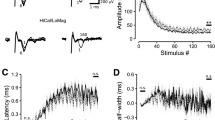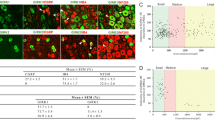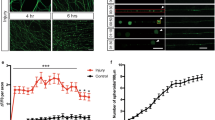Summary
To determine the contributions of sodium and chloride to ultrastructural changes after mechanical injury, we amputated primary dendrites of cultured mouse spinal neurons in low calcium medium in which sodium chloride had been replaced with either choline chloride or sodium isethionate or sodium propionate. Uninjured cultured neurons were also exposed to the sodium ionophore, monensin. A third set of neurons was injured in medium in which all sodium and calcium chloride had been replaced with sucrose. Neurons injured in low-calcium, low-sodium medium exhibited few ultrastructural changes, except very near the lesion, where there was some dilation of mitochondria and cisternae of the smooth endoplasmic reticulum (SER). Mitochondria in other regions of the neurons developed an electron opaque matrix, and those nearer to the lesion converted to the condensed configuration, characterized by expanded intracristal spaces as well as a dense matrix. If sodium but not chloride was present in the medium, there was some dilation of the Golgi cisternae after injury, as well as some increased electron opacity of the mitochondria. Monensin treated neurons also exhibited dilation of the Golgi cisternae. Neurons injured in sucrose-substituted medium showed none of the changes associated with injury in normal culture medium. These results indicate that sodium influx through the lesion is involved in the dilation of the SER, which is seen even in low-calcium medium, and that a permeant anion, such as chloride, is also involved. This dilation of the SER may result from uptake of calcium released from mitochondria in response to elevated cytosolic sodium. Dilation of the Golgi cisternae appears to be a response only to elevated intracellular sodium. Condensation of the mitochondria after injury is thought to be due to increased demands for ATP synthesis and may involve a “futile cycling” of calcium across the mitochondrial membrane, involving sodium-mediated calcium release in response to elevated intracellular calcium.
Similar content being viewed by others
References
Bird MM (1978) Microsurgical transaction of small nerve fibre bundles in vitro. Cell Tiss Res 190:539–552
Borgens RB, Joffe LF, Cohen MJ (1980) Large and persistent electrical currents enter the transected lamprey spinal cord. Proc Natl Acad Sci USA 77:1209–1213
Brierly GP, Jurkowitz M, Jung DW (1978) Osmotic swelling of heart mitochondria in acetate and chloride salts. Arch Biochem Biophys 190:181–192
Bowen ID (1983) Laboratory techniques for demonstrating cell death. In: Davis I, Sigee DC (eds) Cell ageing and cell death. Cambridge University Press, Cambridge, pp 1–40
Carafoli E, Tiozzi E, Lugli G, Crovetti F, Kratzing C (1974) The release of calcium from the heart mitochondria by sodium. J Mol Cell Cardiol 6:361–371
Carafoli E (1982) The transport of calcium across the inner membrane of mitochondria. In: Carafoli E (ed) Membrane transport of calcium. Academic Press, London, pp 109–139
Carafoli E (1984) Plasma membrane Ca2+ handling by intracellular stores: An integrated picture with emphasis on regulation. KROC Found Ser 17:121–134
Carafoli E, Penniston JT (1985) The calcium signal. Sci Am 253:70–78
Crompton M, Künzi M, Carafoli E (1977) The calcium-induced and sodium-induced effluxes of calcium from heart mitochondria. Eur J Biochem 79:549–558
Emery DG, Lucas JH, Gross GW (1987) The sequence of ultrastructural chanes in cultured neurons after dendrite transection. Exp Brain Res 67:41–51
Fischbach GD, Nelson PG (1977) Cell culture in neurobiology. In: Kandel ER (ed) Handbook of physiology. The nervous system. American Physiological Society, Bethesda, MD, I:719–774
Fishman HW, Tewari KP (1990) Ca2+-induced vesiculation in dialyzed squid giant axon. Soc Neurosci Abstr 16:820
Gallant PE (1988) Effects of the external ions and metabolic poisoning on the constriction of the squid giant axon after axotomy. J Neurosci 8:1479–1484
Goldberg WJ, Madingo RM, Barnett JN (1986) Effects of ischemia-like conditions on cultured neurons: protection by low Na+ and low Ca2+ solutions. J Neurosci 6:3144–3151
Gross GW, Lucas JH (1982) Long-term monitoring of spontaneous single unit activity from neuronal monolayer networks cultured on photoetched multielectrode surfaces. J Electrophysiol Techn 9:55–67
Gross GW, Lucas JH, Higgins ML (1983) Laser microbeam surgery: Ultrastructural changes associated with neurite transection in culture. J Neurosci 3:1979–1993
Gross GW, Higgins ML (1987) Cytoplasmic damage gradients in dendrites after transection lesions. Exp Brain Res 67:52–60
Hackenbrock CR (1968) Chemical and physical fixation of isolated mitochondria in low-energy and high-energy states. Proc Natl Acad Sci USA 61:598–605
Lucas JH, Gross GW, Emery DG, Gardner CR (1985) Neuronal survival or death after dendrite transection close to the perikaryon: correlation with electrophysiologic, morphologic, and ultrastructural changes. CNS Trauma 2:231–255
Lucas JH (1987) Proximal segment retraction increases the probability of nerve cell survival after dendrite transection. Brain Res 425:384–387
Lucas JH, Gross GW (1989) Testing of acute phase CNS trauma interventions in vitro: Effects of total ion deprivation on spontaneous network activity. Sixth Neurotrauma Symposium Abstract. J Neurotrauma 6:60
Lucas JH, Emery DG, Higgins ML, Gross GW (1990) Neuronal survival and dynamics of damage after dendrotomy in low calcium. J Neurotrauma 7:169–192
Meiri H, Spira ME, Parnas I (1981) Membrane conductance and action potentials of a regenerating axonal tip. Science 211:709–712
Nedergaard J (1984) Na+-dependent regulation of extramitochondrial Ca2+ by rat-liver mitochondria. Eur J Biochem 144:159–168
Nicholls DG (1986) Traumatically induced axonal damage without concomitant change in locally related neuronal somata and dendrites. Acta Neuropathol (Berl) 70:53–59
Ransom BR, Neale E, Henkhart M, Bullock PN, Nelson PG (1977) Mouse spinal cord in cell culture. I. Morphological and intrinsic electrophysiological properties. J Neurophysiol 40:1132–1150
Rothman SM, Olney JW (1986) Glutamate and pathophysiology of hypoxic-ischemic brain damage. Ann Neurol 19:105–111
Schanne FAX, Kane AB, Young EE, Farber JL (1979) Calcium dependence of toxic cell death: a final common pathway. Science 206:700–702
Siesjo BK, Bengston F (1989) Calcium fluxes, calcium antagonists and calcium-related pathology in brain ischemia, hypoglycemia, and spreading depression: a unifying hypothesis. J Cereb Blood Flow Metab 9:127–139
Tartakoff A, Vassalli P (1978) Comparative studies of intracellular transport of secretory proteins. J Cell Biol 79:694–707
Trump BF, Ericsson JLE (1965) Some ultrastructural and biochemical consequences of cell injury. In: Zweifach BW, Grant L, McCluskey RT (eds) The inflammatory process. Academic Press, New York, pp 35–120
Trump BF, Laiho KA, Mergner WJ, Arstila AU (1974) Studies on the subcellular pathophysiology of acute lethal cell injury. Beit Path 152:243–271
Trump BF, Berezesky I, Mergner WJ, Phelps PC (1978) The role of calcium in cell injury. Micron 9:5–6
Wyllie AH (1981) Cell death: a new classification separating apoptosis from necrosis. In: Bowen ID, Lockshin RA (eds) Cell death in biology and pathology. Chapman and Hall, New York, pp 9–34
Author information
Authors and Affiliations
Rights and permissions
About this article
Cite this article
Emery, D.G., Lucas, J.H. & Gross, G.W. Contributions of sodium and chloride to ultrastructural damage after dendrotomy. Exp Brain Res 86, 60–72 (1991). https://doi.org/10.1007/BF00231040
Received:
Accepted:
Issue Date:
DOI: https://doi.org/10.1007/BF00231040




